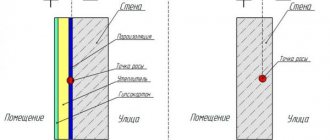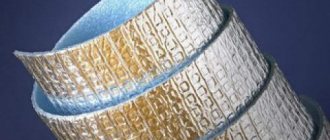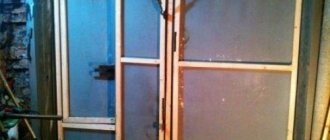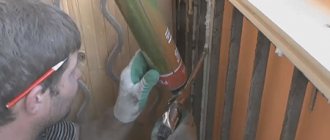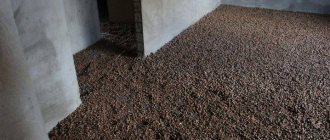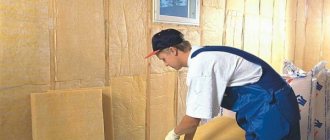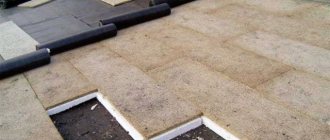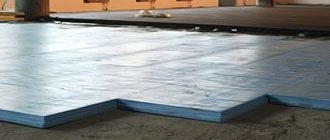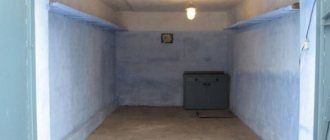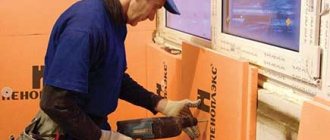What is the most effective insulation?
8 best insulation for home
| 1 | Mineral wool | The best universal insulation |
| 2 | Styrofoam | The most popular and affordable insulation |
| 3 | Extruded polystyrene foam (sandwich panel) | Modern insulation for slopes |
| 4 | Glass wool | The most famous insulation |
| 5 | Foam glass | The highest thermal insulation properties |
Options for winter insulation technologies
It is possible to insulate the facade of a house in winter only in accordance with certain rules. Which technology to use depends on the chosen insulation and finishing material.
"Dry" method
In winter, as a rule, preference is given to “dry” technology. This is due to the fact that during the installation process the use of materials that contain any amount of water is practically excluded. To fix the insulation, metal fasteners or so-called mushrooms (plastic dowels for insulation) are used.
Dry method technology
Several types of heat insulators are more popular as insulation.
- Polystyrene foam and expanded polystyrene have excellent heat-insulating properties. The first one practically does not absorb moisture and does not allow steam to pass through. Expanded polystyrene has zero performance in the same moments. Installation of polystyrene foam is characterized by a large amount of debris, since the material tends to crumble. The insulation is afraid of fire, ultraviolet radiation, acetone, turpentine and drying oil.
- Polyurethane foam has the lowest thermal conductivity coefficient among other insulation materials. It is applied by spraying, so additional fixation does not require the use of fasteners.
- Mineral wool does not deform when temperature and humidity fluctuate and does not burn.
- Basalt and stone insulation do not rot and are not afraid of open fire. Experts consider them the best for winter insulation.
The procedure for facade work includes:
- preparation of the base;
- lathing device;
- insulation gasket;
- covering the structure with a membrane sheet.
This technology allows you to insulate walls built from block products, brick or wood in winter.
The process of insulation using the “dry” method often involves the installation of a ventilated façade. An empty space is created between the insulation and the facing material, which ensures constant ventilation.
This rids the base of excess harmful moisture. This method is more economical than the “wet” one. Among other things, the reason is the opportunity to refuse the services of professionals and do everything yourself.
Insulation using “wet facade” technology
Most construction companies prefer a “wet facade”. It differs in that the thermal insulation is fastened using anchor bolts and plastic dowels. In addition, an adhesive solution is applied to the insulation, and the finished coating is covered with a leveling layer of plaster.
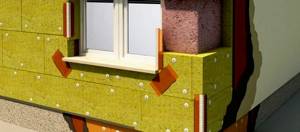
“Wet facade” technology
This solution is suitable for any walls, except for wooden houses and frame-type buildings. The result is lightweight, so foundation load calculations are usually not required.
Despite the justified advantages, “wet” technology is inferior in some respects:
- in winter, it is necessary to observe the minimum thermometer reading at which it is possible to use a particular material;
- the installation process is more labor-intensive and takes longer;
- walls require preliminary preparation: cleaning of protruding elements, dirt and dust;
- leveling the base;
- primer treatment.
Manufacturers, taking into account the possible use of materials in winter, offer to purchase special additives. They allow you to reduce the threshold of acceptable temperature for work to -15°C.
Let's sum it up
It is advisable to carry out construction activities and insulation work during the warm period of the year. However, provided that technological recommendations are followed and effective heat insulators are used, measures can be carried out in winter.
Is it worth insulating a wooden house from the inside? This question is asked by all people who have recently purchased this type of real estate. Some insulate from the inside, some from the outside, and some choose both options for a more comfortable existence. In this article, it is necessary to examine in detail the question of whether it is worth insulating a wooden house from the inside.
How to avoid condensation
To do this you need:
- Use a high-quality multi-layer membrane for waterproofing. Plastic film will not work. In addition, it must be laid correctly - overlapping, with sealing of the joints.
- Choose insulation with minimal vapor permeability. If the material from which the walls of the house are made is higher, then the moisture formed between the insulation and the surface of the wall will not condense, but will come out.
- Install the insulation close to the wall. To do this, glue must be applied to it in an even, continuous layer, and not in beacons.
- Provide forced ventilation of the room, as well as install windows with air exchange valves.
- Accurately calculate the thickness of the insulation layer. You cannot rely on average parameters, since it is possible to properly insulate walls only by taking into account all the characteristics of a particular material, room and climatic features of the region.
- Treat the insulated wall with antifungal and antibacterial agents. You can use a special antiseptic primer. You can start working only after the wall surface is completely saturated and dry.
When insulating an apartment from the inside, it is very important to get rid of all possible cold bridges. They form at the joints of insulation boards and in those places where the wall connects to ceilings and internal partitions
To improve the efficiency of insulation, it is necessary to lay thermal insulation material extending onto the internal walls, floor and ceiling.
What else is important to pay attention to
It would not be superfluous to say that insulation should be done comprehensively. In this case, when carrying out work indoors, it is recommended to insulate ceilings and floors with excellent vapor insulation, at least in small areas near problem walls. if there is a window on the walls, then it is very important to make excellent thermal insulation of the area near the window sill and slopes. In order to preserve the integrity of the insulation material and vapor insulation sheets to the maximum, it is better not to place sockets, plumbing outlets, as well as built-in lamps and other similar elements on such a wall. Sealing a wall that is insulated in this way can sometimes cause a sharp increase in air humidity in the home. For this reason, it is important to be careful about how you provide ventilation. The solution will be to install exhaust fans on the exhaust duct, install supply valves on the walls/windows, and maintain the required gap under the door leaves between rooms, which will ensure ideal air flow.
Plastering the facade: step-by-step execution of work
The multilayer structure, which is the result of the work, implies their stage-by-stage sequential implementation in the following order:
- Preparatory work.
- Insulation fastening.
- Fastening the reinforcing mesh.
- Plastering the surface of the walls.
Preparatory work
Plastering (grinding) the facade of a house over insulation can be carried out at air temperatures from +15°C to +20°C. In the cold season, the thermal contour is created artificially with the help of scaffolding, windproof film and fan heaters.
Preparation of the wall surface consists of removing the previous coating (if there was one), cleaning it from dirt and dust, washing and drying. All unstable fragments are embroidered and filled with putty. If the insulation is attached to glue, it is better to level the surface of the walls as much as possible. Next, the surfaces are primed, choosing a composition that is compatible with the insulation and wall materials.
Installation of insulation
The insulation boards are placed on the glue in horizontal rows from bottom to top, staggered, avoiding the formation of continuous vertical seams (displacement of at least 20 cm). The level difference between the slabs should not exceed 3mm. After the glue has dried, the slabs are additionally secured with umbrella dowels. Fastening is carried out in the center and at the joints, carefully, without deforming the slab.
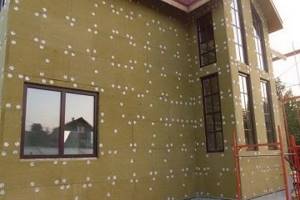
Fastening the reinforcing mesh
The mesh is mounted on plastic fasteners or on plaster (minimum layer 2mm). Work begins with the corners, having previously mounted a perforated corner profile on them. It is also placed on the plaster, and a reinforcing mesh is fixed on top of it.
Plastering the wall surface
The application of plaster begins three days after installation of the reinforcing mesh. Plastering is carried out in the usual way - along the beacons. The maximum layer thickness is 15 mm. If more is needed, then after the first layer has dried, another one is applied. When the surface of the walls is leveled and the top layer has “set”, it is rubbed with a grater soaked in water to completely remove possible defects.

Next, you can proceed to painting the surface. However, it can be avoided by using decorative plaster mixtures at the final stage of work. Call Cottage Expert, and our specialists will tell you the optimal solution for your home - aesthetically pleasing, durable and with a minimum investment.
Questions and answers
Question: Can insulation of walls from the inside be successful?
Answer: Maybe. But in exceptional cases. To do this, 8 conditions must be met. They live in the premises permanently. Ventilation is carried out according to standard. Heating too. All structures are insulated. The wall is thick and warm. According to calculations, no more than 50 mm of foam is required to insulate it. Heat transfer resistance is less than 30%. In simple terms, in a warm region with good ventilation and heating, in a residential building with thick walls, you can insulate the walls from the inside!
Question: What can be done if the walls have already been insulated from the inside?
Answer: First of all, it is necessary to establish ventilation (check and clean the hoods). Plastic windows should be opened for ventilation for at least half an hour a day. An additional heating source will also help reduce condensation. However, it is important to understand that the problem will completely disappear only after proper insulation of the outside walls of the house.
The consequences of improper wall insulation are not immediately noticeable. At first the house is warm and, at first glance, dry. Residents of the house discover the appearance of fungus approximately 2-3 years later, when it covers a significant area and spreads to the finishing. Typically, bursts of mold activity occur during the cold season, when large temperature changes occur. An attempt to save money turns into a complete failure. We have to redo everything “according to our minds.” That’s why they say that insulating walls from the inside is a disastrous business.
Comparison of insulating materials depending on operating conditions
All materials used for thermal insulation of buildings outside have their pros and cons. One of the important indicators is price, which is well reflected in Table 5.
However, parameters such as resistance to moisture, flammability and toxicity should also be taken into account (according to GOST standards 12.1.044-89).
Table 5. Comparison of performance of thermal insulating materials.
| Material type | Coefficient of thermal conductivity | Density (specific gravity) | Flammability | Toxicity | Price*, euro per cubic meter |
| Plant and animal fibers (flax, cotton, hemp, hemp, cellulose, sheep) | 0,035…0,04 | 15…40 (up to 70 for cellulose) | G4 | T3, T3 | 15…40, up to 250 for flax fiber mats |
| Wood, wood fiber, cork | 0,039…0,2 | 110…700 | G4 | T3, T3 | 100…150 and more |
| Fiberglass and mineral (stone) wool | 0,035…0,038 | 15…80 | NG, G1 | Non-toxic | 30…60 |
| Expanded polystyrene | 0,035 | 15…40 | G3, G4 | T3, T4 | 25…80 |
| Polyurethane foam (including polyurethane foam) | 0,03 | 25…35 | G3, G4 | T3, T4 | 220…350 |
| Styrofoam | 0,035…0,05 | 15…35 | G3, G4 | T3, T4 | 25…40 |
*Prices are given for the Moscow region as of January 2021 and are indicative
Thus, based on the above comparative characteristics, we can conclude: stone wool is optimal in terms of price/performance ratio, especially with a high fire threat and in a humid climate.
For those who care most about the ecology of their home, materials based on plant fibers are suitable, but they will require very high-quality waterproofing, are fire hazardous and are not very easy to install.
If the thickness of the insulation is critical, it is worth choosing polyurethane foam in the form of foam, but in this case the costs will be significant.
Nuances of insulating the facade of a wooden house in winter
Houses made of wood essentially require the use of protective materials, since the log house is easily exposed to any natural phenomena.
If you decide to insulate the facade in winter, then you need to take into account some nuances:
- polystyrene foam must be immediately treated with protective compounds to avoid its rapid destruction;
- the choice of “wet facade” technology is appropriate only if a thermal curtain is created;
- wooden buildings can be insulated only after their complete shrinkage, which occurs during the first three years.
As for the insulation, it must be a barrier to moisture, “breathe” and retain heat. Mineral wool, polystyrene foam, ecowool or polyurethane foam cope with these tasks.
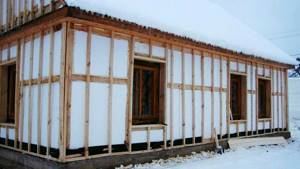
Foam insulation
Insulation of wooden walls in winter occurs in several stages:
- wall preparation includes the absence of protrusions and treatment with bioprotective compounds;
- covering the facade with a waterproofing sheet with an overlap of 10 cm;
- The sheathing is assembled from 50x50 mm timber;
- insulation is laid into the voids and secured with dowels;
- the structure is covered with an overlapping membrane sheet and attached to the beam with staples;
- It is recommended to additionally secure a metal mesh against rodents;
- a frame is assembled for the facing material - siding or lining.
The final coating can be decorative plaster, or it can be applied to treated polystyrene foam. In harsh climates, as a rule, the base is additionally insulated. To do this, you can use expanded clay.
